The new Lexus UX offers the brand’s innovative luxury and safety in a package that combines bold new design elements and ultra-efficient new powertrains. For many customers, the UX will not only be their first Lexus, but also their first luxury vehicle.
The UX name is derived from the design team’s guiding concept and describes the vehicle’s mission: Urban + X-over (crossover) = UX.
“The Lexus UX is designed for the modern urban explorer seeking a fresh, contemporary and dynamic take on luxury driving,” said Chika Kako, executive vice president of Lexus International and chief engineer of the UX. “We designed the UX to appeal to buyers in their 30s who seek not only what is new and exciting, but what is also relevant to their lifestyles.”
Infused with dynamic attitude, the UX is engineered to deliver quick and engaging driving with a Lexus-smooth demeanour, making it a unique entry in the luxury compact crossover segment.
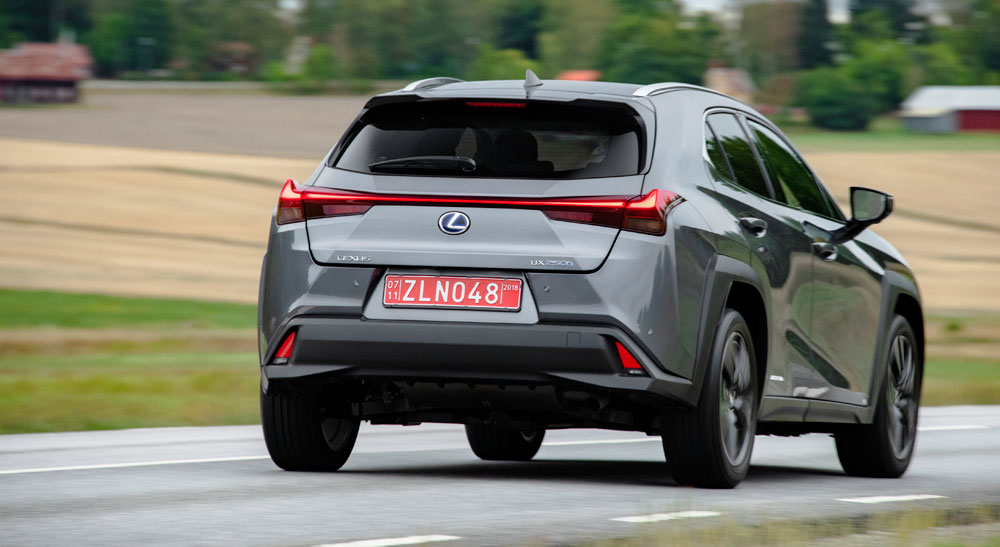
The UX is the first Lexus constructed using the new Global Architecture – Compact (GA-C) platform. A lightweight yet super-rigid structure, extremely low centre of gravity and refined suspension tuning endow the UX with exemplary handling agility and ride comfort, along with a distinctive driving personality.
“I wanted to positively overturn the image of a crossover with a high body that requires careful manoeuvring, and offer a car with nimble performance and excellent manoeuvrability that makes it as easy to drive as a sedan,” said Chief Engineer Kako.
The UX is available in two versions: the UX 250h with a fourth-generation self-charging hybrid powertrain featuring a new high-efficiency 2.0-litre, four-cylinder petrol engine engineered specifically for this platform, and the UX 200 where the 2.0-litre petrol engine is coupled with a new Direct-Shift Continuously Variable Transmission (D-CVT).
EUROPE – A KEY MARKET FOR THE NEW LEXUS UX
The European market offers great potential for the new Lexus UX, a region in which customers are increasingly looking for premium quality alternatives to conventional sedans, wagons and hatchbacks that better suit modern lifestyles. Although this has led to a wealth of choice in the growing compact crossover / SUV segment, the UX stands apart from the competition as more distinctive, stylish player with strong dynamic appeal and the unique benefit of Lexus’ clean and efficient self-charging hybrid technology.
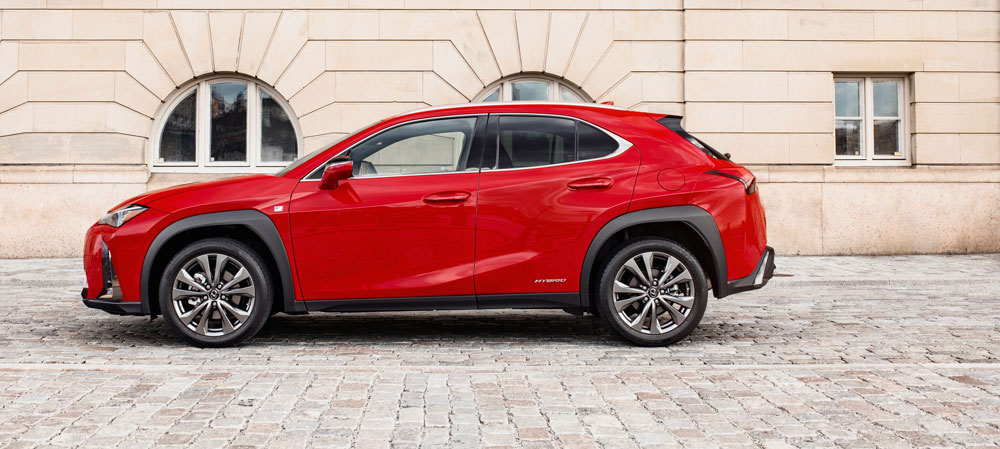
In essence the UX is a new genre of crossover, an “urban explorer” that offers a new take on what luxury means for today’s motorists. Alongside the well-established CT hatchback, it will take its place as a gateway model for Lexus and will play a key role in helping the company achieve its target of 100,000 annual sales in Europe* by 2020. Its self-charging hybrid technology has growing appeal, as the market moves away from diesel power to embrace alternative, electrified powertrains.
The UX will have broad appeal in Europe, particularly for customers with young families who want the flexibility of a crossover, but also a car that’s as agile to drive around town as a hatchback. In this regard the UX will be the ideal partner for day-to-day travelling as well as journeys to discover new places and enjoy new experiences. At the same time, the UX will be a prime choice for downsizing households where the children have grown up, and for couples whose travel often mixes business with leisure.
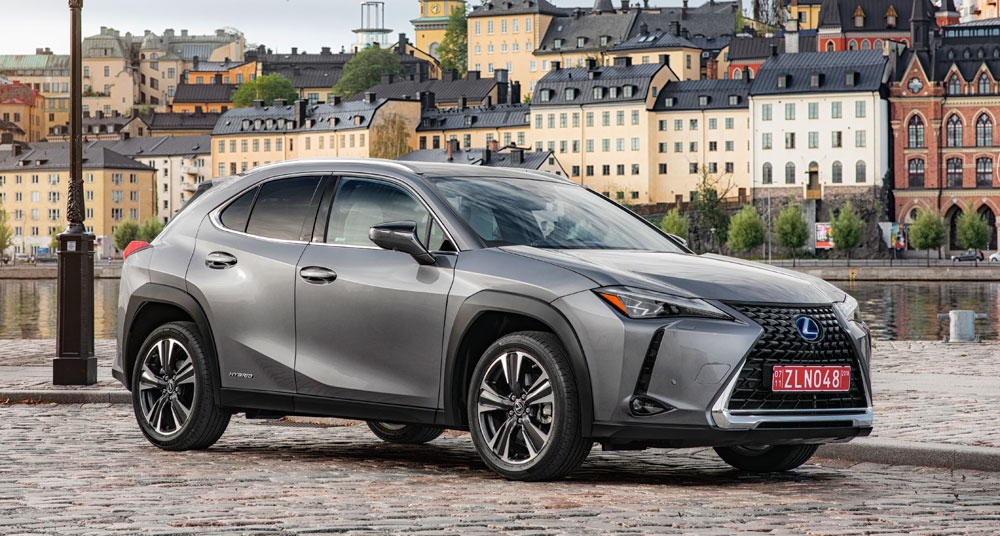
As Lexus’ first compact crossover, the UX joins its larger NX and RX stable mates to complete a powerful European SUV and crossover range that fully expresses the pillars on which the brand has been transformed: brave design, exhilarating performance, imaginative technology and takumi superior craftsmanship.
*Lexus Europe sales include the European Union countries, Norway, Iceland and Switzerland, as well as the following Eastern markets: Russia, Ukraine, Kazakhstan, Caucasus region, Turkey and Israel.
EXTERIOR DESIGN AND AERODYNAMICS
Lexus designers created an overall design theme combining strength with refinement, stylish yet functional.
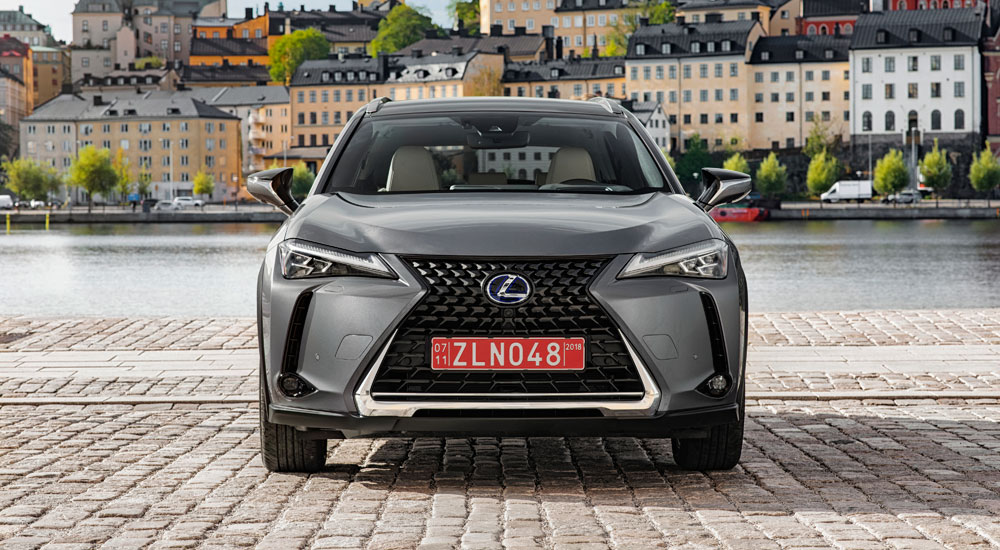
The spindle grille, though sharing its basic shape with other Lexus models, is unique to the UX. It features a new mesh pattern with individual elements that gradually change in shape as they radiate out from the central Lexus emblem. The grille creates an intriguing three-dimensional appearance that appears to change with the viewing angle.
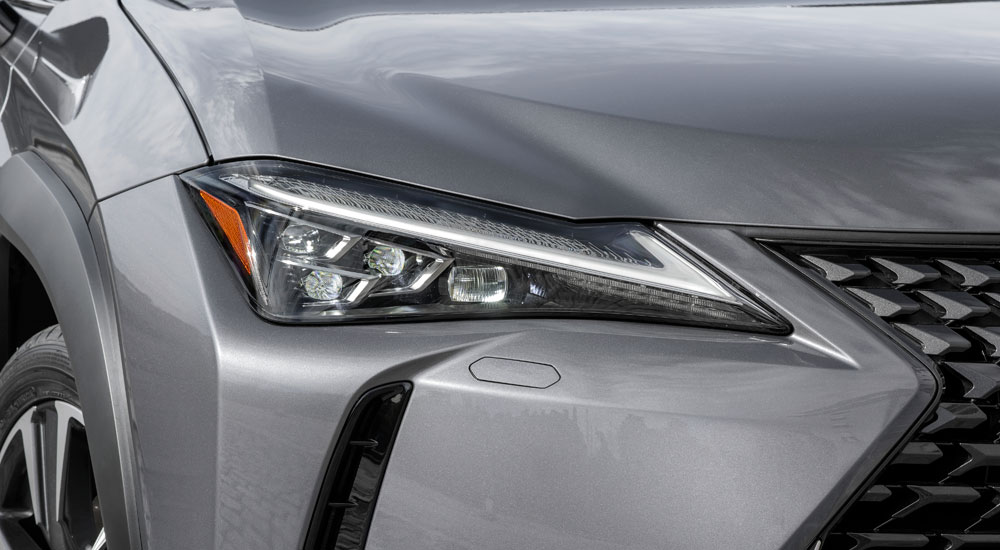
The headlamp design completes the UX’s face, giving it a determined, confident gaze. Daytime running lights are arranged in an arrowhead motif above the headlights, emphasizing the Lexus L-shaped lighting signature. These appear like brows above the standard single-projector dual-beam LED headlights or the optional ultra-small 3-projector LED units.

The vehicle’s basic form flows out from the lines of the spindle grille to envelop the cabin. Crisp, prominent sculpted surfaces and dramatically flared front and rear wings reflect strength, while an aerodynamic profile, large wheels pushed to the corners and a bold front fascia create the agile stance.
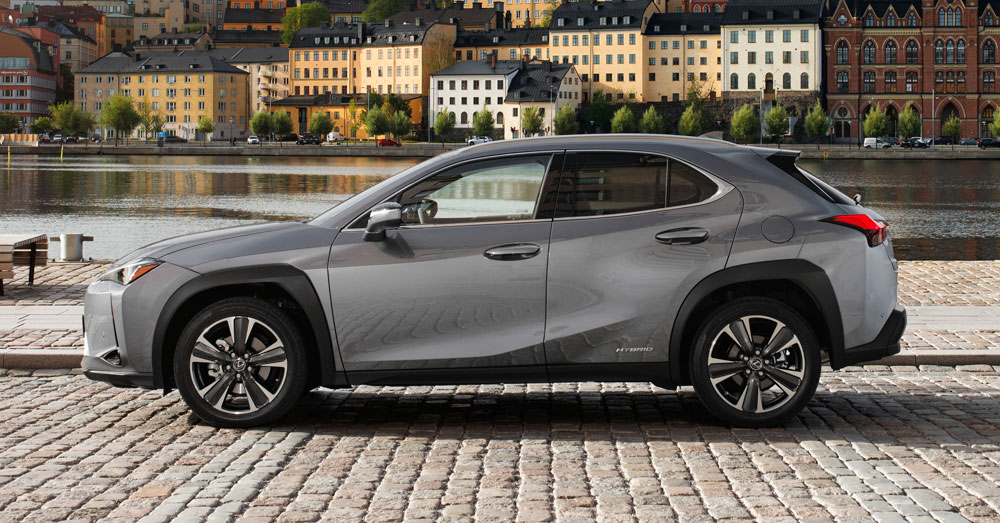
The wheel arch mouldings that protect the body from gravel thrown up by the tyres, use airflow over their edges to reduce turbulence and lift, contributing to the vehicle’s stability.
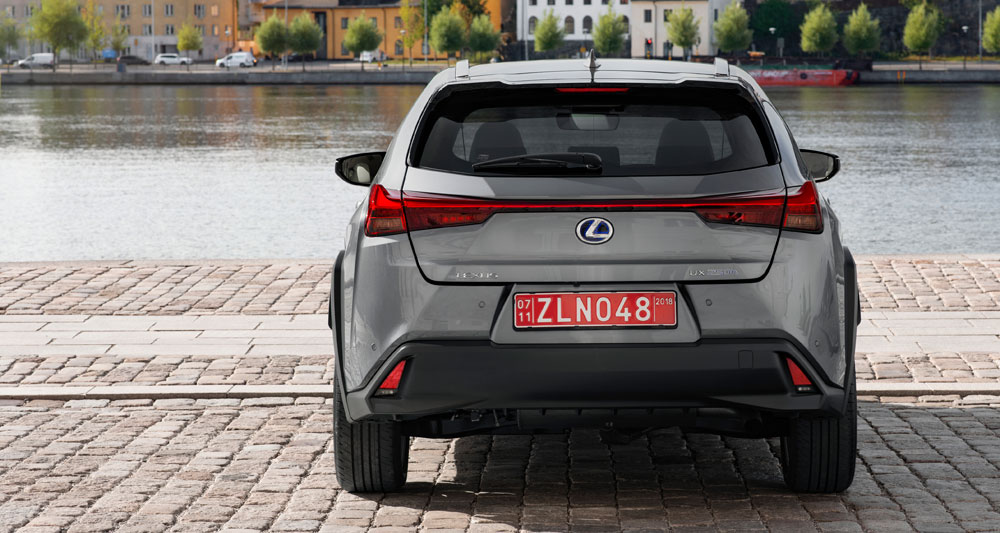
A similar contribution is made by the rear combination lamps. The Aero Stabilising Blade Lights begin at the top of the rear wings and span the rear of the vehicle. By guiding airflow around the rear of the UX, this design also reduces turbulence and lift, contributing to vehicle stability when cornering and driving in crosswinds.
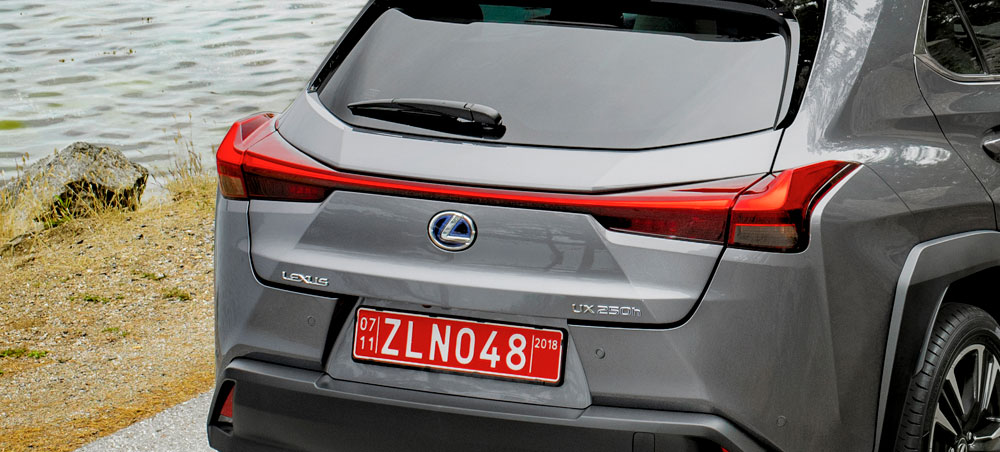
The full-width lights project a distinctive night-time signature formed by a sequence of 120 LEDs and tapering toward the centre, measuring just 3mm thick at its narrowest point. A wing-type spoiler at the rear edge of the roof, along with a flat underbody, contribute to vehicle quietness and fuel efficiency.
Takumi (Japanese for “artisan”) modellers worked with design and engineering to refine all exterior surfaces of the UX. Their work was crucial to refining surfaces down to the 0.01 mm level, pushing the boundaries for what could be produced in the body-stamping presses.
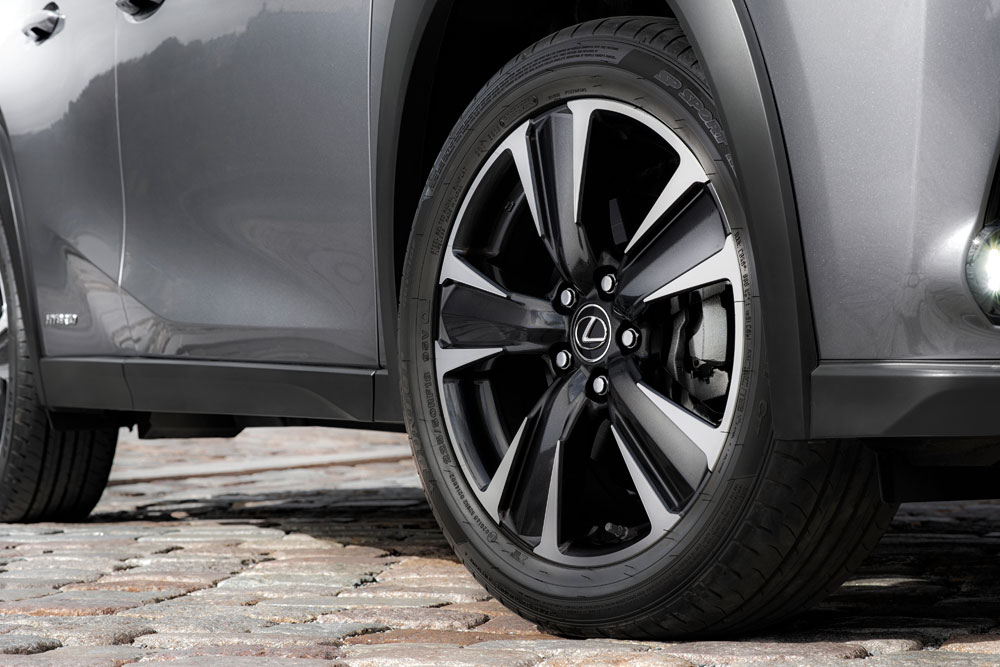
The standard 5-spoke 17×6.5-inch aluminium alloy aero ventilating wheels feature Gurney flaps along the spoke edges designed to reduce wind resistance while also increasing the airflow to cool the disc brakes.
The design pulls air from the inside of the wheel, while the air flow on the outer side of the vehicle is regulated to follow the wheel surface. The aero wheels are available in a choice of silver metallic and dark grey metallic colours. The UX also offers (non-aero) 18-inch aluminium wheel designs including exclusive F SPORT-specific wheels.
COLOURS AS UNIQUE AS THE UX
The Lexus UX is offered in a total of 13 exterior colours that accentuate the vehicle’s bold lines.
Three exclusive new colours were developed for the UX:
- Blazing Carnelian creates vividness and a sense of depth using a multi-layer painting process that combines a red colour base layer with a yellow interference mica layer.
- Terrane Khaki offers a strong contrast between bright highlights and dark, calm shades. The mica particles have been enlarged as much as possible without creating colour unevenness, achieving high brilliance while expressing toughness.
- Celestial Blue creates a solid blue colour with glass flakes that sparkle in sunlight.
INTERIOR DESIGN: A NEW KIND OF LEXUS LUXURY
Lexus designed the UX cabin to evoke the feel of a dynamic, luxury sedan, but with the higher seating position and versatility desired in a crossover. The materials and workmanship are pure Lexus, combining Japanese traditions in craftsmanship and hospitality with innovative production techniques.
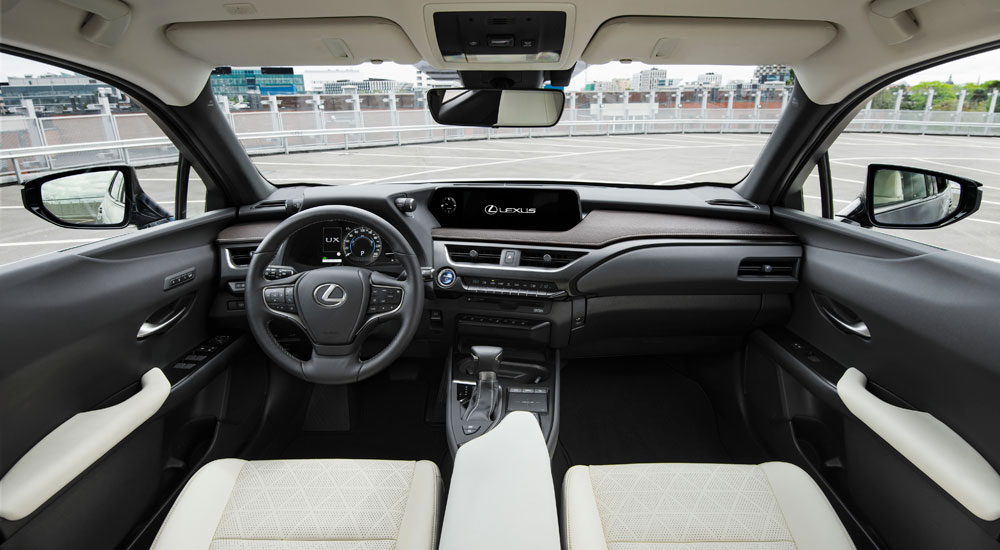
At the same time, the UX interior design also conveys a sense of security. As one example, the form of the interior door shoulders evokes a robust frame, expressing a secure feeling inside the vehicle.
Inspired by a traditional Japanese concept that blurs the boundary between a home’s exterior and interior, designers created a feeling of seamless continuity inside the UX. From the driver’s seat, the upper section of the instrument panel appears to extend out beyond the windshield into the wings. The result gives the driver an excellent field of vision and a clear sense of the vehicle’s dimensions and tire placement. When viewed from outside the vehicle, the hood appears to connect directly to the instrument panel through the windshield.
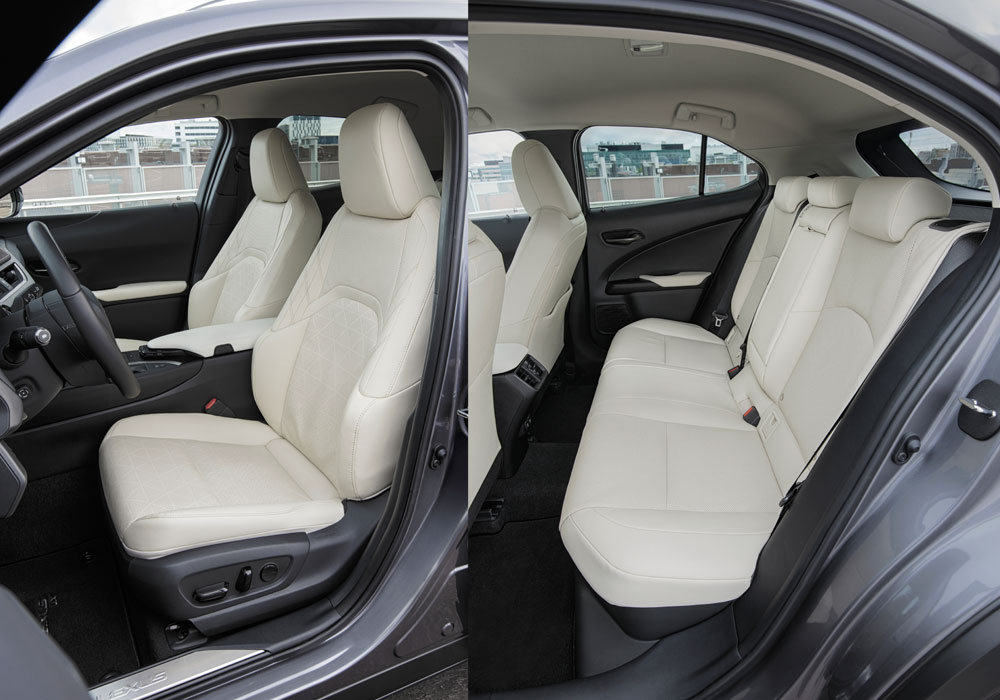
Entering and exiting the UX is made easier through optimal placing of the hip-point and unique shaping of the seat cushion. The human-centred approach shows clearly in the instrument panel’s low, unobtrusive design and slim A-pillar mouldings, which are shaped to improve visibility. Even with a higher seating position than a standard passenger car, the reduction in distance between the hip and heel points gives the UX driver a feeling of being closer to the road than in a conventional SUV.
Typical of Lexus, the UX offers a quiet driving experience, thanks to the high-strength structure and optimal placement of specially designed sound- absorbing and insulating materials throughout the body. Also in typical Lexus fashion, engineers traced noises to their sources to keep them out of the cabin. Even the sound of water being thrown by the tyres is reduced.
“SEAT-IN-CONTROL” CONCEPT
The UX makes the driver feel more in touch with the road thanks to a “seat-in-control” concept. Critical vehicle functions are grouped around the driver’s side of the cabin, and the seatback shape allows the driver to operate them while maintaining a comfortable, natural posture.
The UX offers 6-way manual or 8-way power adjustable front seats, the latter with adjustable lumbar support for the driver. Front seat cushions use springs and foam specially designed to gently envelop occupants and to disperse pressure under the occupant’s sciatic area.
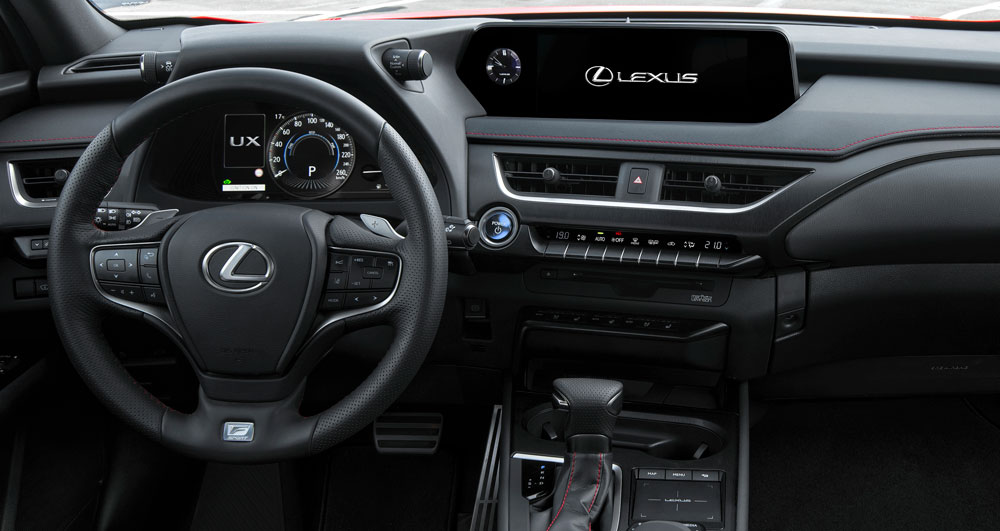
Lexus luxury extends throughout the UX cabin. The three-spoke steering wheel and analogue clock come from the Lexus LS, for example, and Lexus Climate Concierge, as used in other Lexus models, automatically links heating and cooling airflow with the heated and ventilated seats to optimise interior temperature comfort. Renowned Lexus attention to detail is also evident in a headliner design that eliminates distracting shadows at the windshield header, as well as control switches with a signature “Lexus feel.”
LUXURIOUS NEW FINISHES
From its inception, Lexus has drawn on Japanese traditions in craftsmanship and hospitality to infuse its vehicles with a unique sense of contemporary luxury. Lexus adapted this approach to the UX to appeal especially to younger customers experiencing their first luxury vehicle.
Chief Engineer Kako drew on her extensive experience in materials development and time spent working in Europe to help define the UX interior’s appearance and quality. The result is an uncluttered “less is more” approach that makes the UX feel more inviting and accessible.
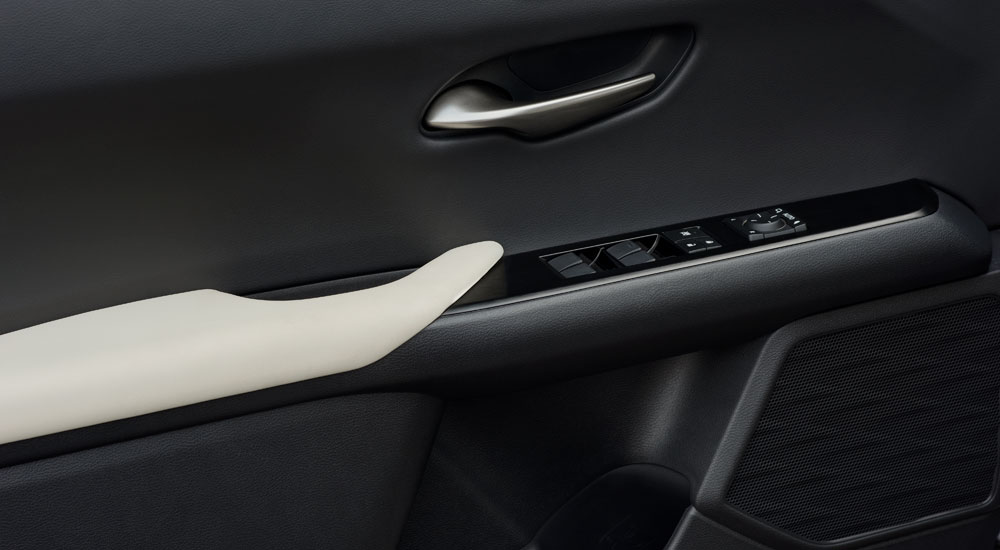
“When it comes to determining whether an interior is good or bad, controlling the overall balance between the continuity, unity and contrast is more important than the relative specifications of individual components,” she said.
One example is an optional leather upholstery finish inspired by sashiko, a customary Japanese stitching technique that is also used in the making of judo and kendo martial arts uniforms. It’s combined with a “calculated art” perforation pattern on the lower part of the seat that is derived from mathematical curves and gradations in perfect alignment.
The Lexus UX offers a wide choice of interior colour combinations, each of which conveys a specific mood and accentuates the premium design. The seating is available in fabric, leather or a combination of fabric and Tahara leather. The standard models offer a choice of five colours, including Cobalt, Black, White Ash, Rich Cream and Ochre. In addition to Black, the F SPORT also offers exclusive Flare Red and White seat colours.

The sweeping instrument panel and cabin trim offer a choice of two different grain patterns and four colours. In a Lexus first, the UX offers a new trim finish inspired by Japanese paper, known as washi. It’s common in traditional Japanese homes and it evokes a calm and warm feeling. A leather-like grain finish, also featured in the Lexus LC coupe and LS sedan, is also available.
INTUITIVE CONTROLS AND CLEAR DISPLAYS
The UX instrument panel design combines unique Lexus traits and intuitive technology. A 7-in. TFT LCD display meter digitally creates realistic, analogue gauges in a three-dimensional space.
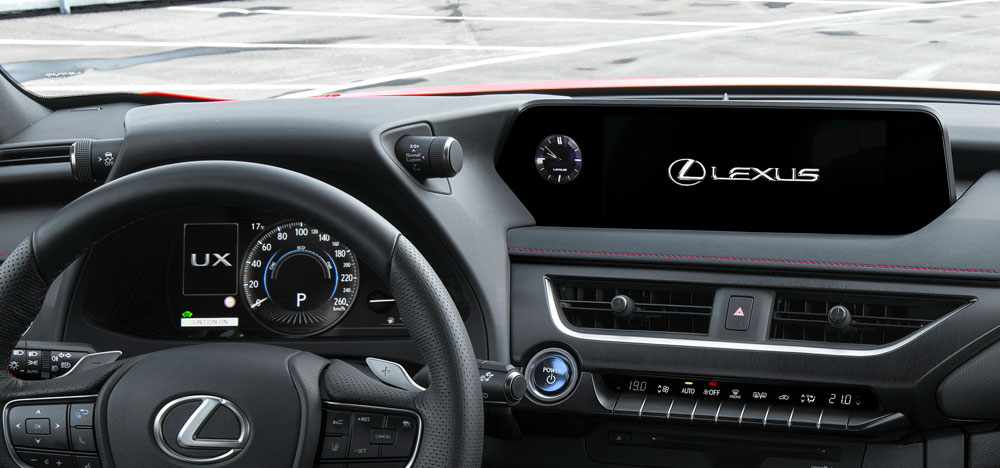
An available head-up display underscores the Lexus UX’s high-tech feel while putting vital vehicle information in the driver’s line of sight. The large colour display projects the information to a virtual “screen” 2.5m (8 ft.) in front of the driver, making it easier to focus on the display as well as objects in front of the vehicle. The bright, high-contrast display is easy to see in daylight and in snowy conditions.

The Lexus Remote Touch Interface (RTI) with haptic interface in the UX is designed to feel as familiar to use as a smartphone. The RTI utilises intuitive operations, such as double tapping and flicking, to mimic common phone gestures. Frameless construction eliminates edges, and a special coating on the touch pad surface lets fingers easily slide over it while minimizing the appearance of fingerprints. The touchpad can recognize Roman block letters when typing a search name. Touchpad surface haptic vibrations indicates to the user when the cursor is moved, making it easier to align the cursor with the desired function button.
A switch at the base of the touch pad can call up an operation screen with related functions, such as air conditioning and navigation, enabling easier access without going through menus. In a unique touch of high-tech elegance, the Lexus logo on the pad surface is backlit at night.
IMAGINATIVE TECHNOLOGY
Lexus designers created a refined cabin atmosphere, for instance by integrating subtle LED cabin lighting. White LEDs illuminate the front foot wells, glovebox, and console switches and also serve as the dome light, map lights and cargo area light.
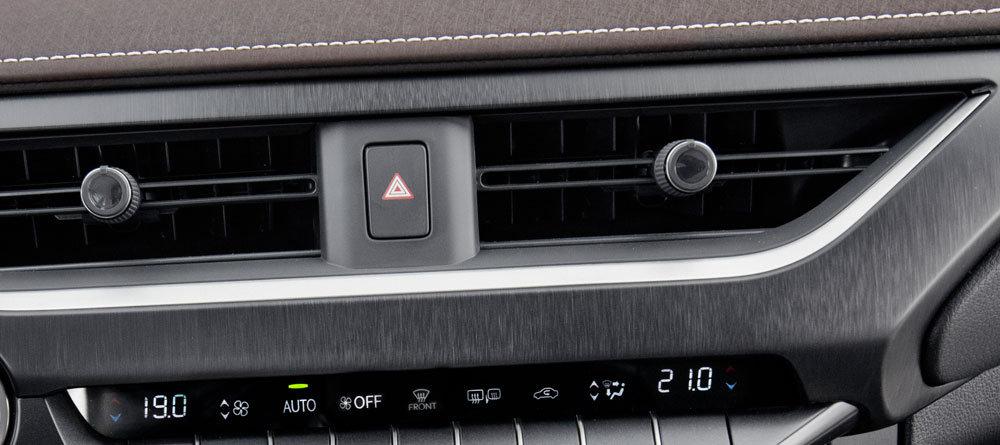
As another example, each of the UX’s air vents uses a new single-knob control for airflow direction and volume. By combining the two functions in a single control, the air passages of each vent could be made larger, improving airflow while reducing noise.
Luxury-grade models feature illuminated vent controls with distinctive LED light source wirelessly powered by electromagnetic resonance of two adjacent coils vibrating at the same frequency. Using the same design principle as the Lexus LC’s rear combination lamps, the vent control LEDs use mirror optics to create the effect of floating lighting depth, even though the light element is just 3mm thick.
VERSATILITY THROUGH THOUGHTFUL PACKAGING
The UX package is suited to making urban exploring easier. A 2640mm (103.9-in.) wheelbase contributes to a smooth, stable ride and cabin roominess. The 4495mm (177-in.) length and best-in segment 10.4m (34-ft) curb-to-curb turning diameter help make the Lexus UX easy to manoeuvre and convenient to park.
Getting in and out is made easier through several factors including optimal placing of the hip-point, a cut-off profile for the rocker panel below the doors and the shape of the seat cushion. For interior storage, the UX offers the largest console box in its class.
An available hands-free power rear gate makes loading the UX more convenient, and solid aluminium roof rails allow installation of a variety of accessory carriers.
Depending on model configuration, tyres and markets, the UX features a repair kit, run-flat tyres or a spare tire. The newly-developed 2nd generation run-flat tyres are quieter and more comfortable, while now allowing the vehicle to travel with a flat tire at speeds up to 80 km/h (50 mph) for up to 160 km (99 miles).
IMMERSIVE TECHNOLOGY AT YOUR FINGERTIPS
The Lexus UX models offer the latest in the brand’s multimedia and navigation technology. A 7-inch EMV (Electro Multi Vision) display is standard, and a 10.25-in. EMV display is used with the available Lexus Navigation system.

The standard Lexus Premium Sound System can play back the highest-resolution digital audio formats (WAV, FLAC, ALAC, and OGG Orbis) from a USB device, conveying more musical data than a CD. Dual rear-seat USB ports enable passengers to use and recharge their smartphones or tablets.
The standard 6-speaker system and available 8-speaker upgrade system use bamboo charcoal speaker diaphragms to reduce mass and deliver natural-sounding voices and improved mid-range sound. Both systems create a more lifelike soundstage by using tweeters mounted at the sides of the instrument panel, and reflecting sound off the windshield. The 8-speaker system adds a centre-dash tweeter, a subwoofer mounted in the luggage area and a more powerful amplifier.
The available Mark Levinson Premium Surround Sound System – a segment exclusive – uses a 13-speaker array, low-distortion 668W Class D 8-channel amplifier, Quantum Logic Surround Sound and ClariFi™ 2.0 technology to deliver an immersive concert-like sound experience in the UX.
A SOLID STRUCTURE TO BUILD ON
Lexus instilled the UX with an outstanding combination of handling agility and smooth, quiet ride comfort that urban customers will find pleasing. Key to achieving that balance is building the UX around the high-strength GA-C global architecture platform. Extensive use of high-tensile steel, high-strength adhesives and Laser Screw Welding results in a highly rigid structure, an essential foundation for achieving dynamic handling and luxurious ride comfort.
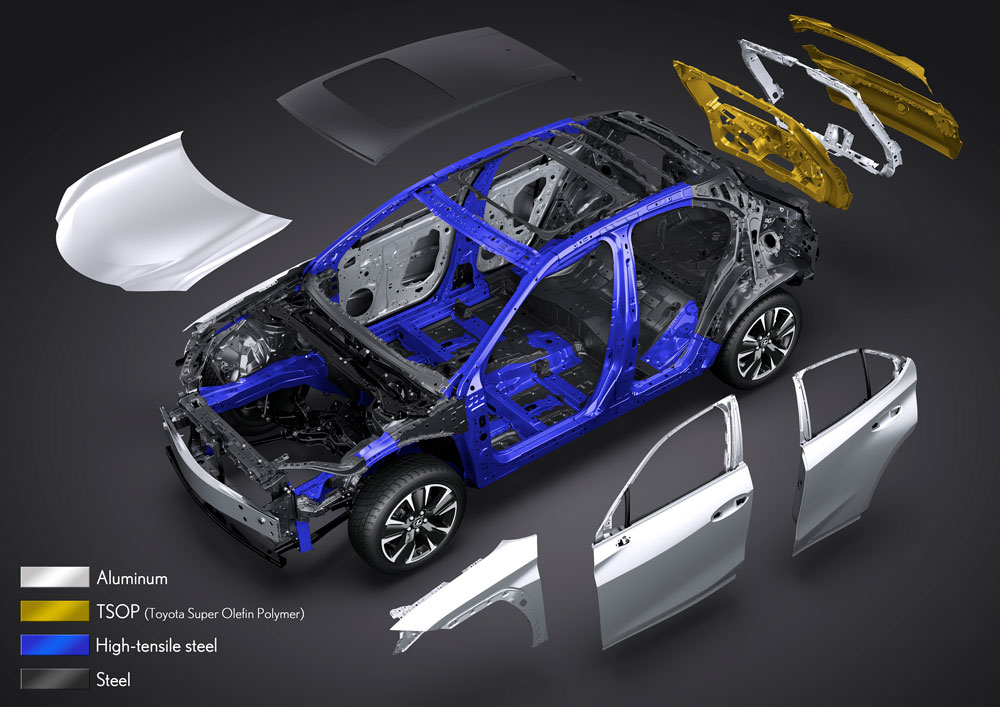
By using aluminium for the side doors, wings and hood and composite materials for the tailgate, the UX has the lowest centre of gravity of any vehicle in its class (594mm / 23.4 in.). As a result, the UX delivers a secure, agile feeling normally associated with lower dynamic hatches. A unique ring structure around the hatch opening and behind the rear seats increases torsional rigidity to enhance crash performance, improve handling and reduce noise and vibration.
The MacPherson strut front suspension and multilink rear suspension with trailing arms, both mounted to subframes, are specially tuned to deliver a combination of agility and comfort over well-worn urban street surfaces. Carefully refined details such as the quality of the damper oil, oil seals and friction control in the shock absorbers make a significant positive impact on ride quality.
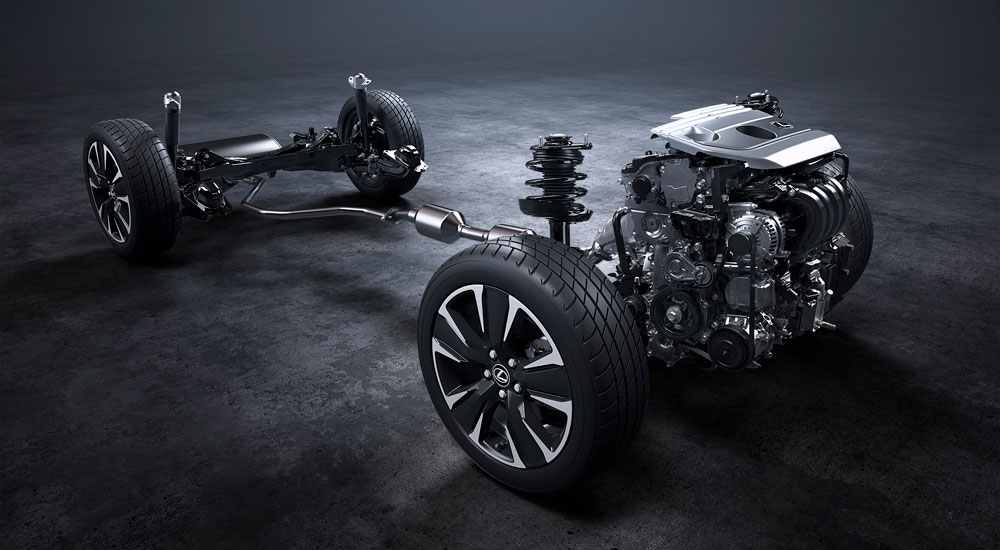
An upper strut brace increases torsional rigidity of the engine bay, and the steering rack bolts directly to the subframe without rubber bushings for improved steering feel.
Active Cornering Assist (ACA), a function integrated with Vehicle Stability Control (VSC), helps the vehicle trace the driver’s desired line through a turn by applying some brake control on the inside wheels, suppressing the tendency to understeer. As a result, the UX drives through corners with greater precision while maintaining stability.
A SUSPENSION THAT ADAPTS TO YOUR NEEDS
The latest version of Lexus Adaptive Variable Suspension (AVS), which debuted on the flagship LC Coupe, is available for the UX F SPORT and Luxury grades. The new AVS system decreases body roll when cornering and enhances ride comfort over bumpy urban streets.
AVS uses linear control solenoids to vary the amounts of shock fluid to bypass the shock absorber’s piston assembly. Thus, the system can vary suspension damping through 650 levels, making its operation transparent to the vehicle occupants.
Based on signal inputs from the steering, yaw rate and linear G sensors, AVS continually adjusts damping force to minimize body roll in cornering while maintaining optimum tire contact and ride comfort on all surfaces. Damping force is reduced at low speeds and increased at high speeds. Integrated functions including Roll Posture Control, Anti-pitch Control, Repercussion Control and Roughness Sensing Control adapt AVS performance to all road surfaces and driving dynamics.
The driver can set damping performance using the Drive Select controller. When Eco, Normal or Sport S mode is selected, or when Custom mode is selected with the chassis setting in NORMAL, the damping force remains unchanged to maintain an optimal balance of ride comfort, steering response and a flat ride.
By selecting Sport S+, or Custom mode with the chassis setting in SPORT, the damping force control mode switches to firmer dampers settings to provide the most dynamic driving feel.
In addition, using Pre-Collision System Cooperative Control, AVS can instantly increase damping force to limit vehicle pitch or roll when the driving support computer judges that there is a possibility of rapid driver input to avoid a collision. VSC Cooperative Control applies appropriate damping in response to vehicle side-skid and changes in the road surface friction, helping to maintain the effectiveness of VSC.
SHARP STEERING AND MULTIPLE WHEEL OPTIONS
An Electric Power Steering system with a new compact and highly rigid column assist motor delivers handling with crisp, immediate response to driver inputs, and provides excellent steering feel.
A newly developed electric tilt and telescopic steering column is available for UX models equipped with power-adjustable front seats. In addition, on models with memory function, ingress and egress are made easier with the auto away / auto return controls linked to the driver’s seat belt and the engine start-stop switch or hybrid power switch. Using the switch, the tilt and telescopic motors can adjust the steering wheel up and down or forward and back through 40mm ranges.
Standard 17 x 6.5-inch alloy aero ventilating wheels feature 215/60R17 tyres. The optional 18-inch alloy wheels get 225/50RF18 95V run-flat tyres. F SPORT models are available with performance summer tyres.
UX 250h: NEW-GENERATION LEXUS HYBRID DRIVE
The UX 250h is equipped with a new-generation Lexus Hybrid Drive powertrain. With 178 PS total system output, the UX 250h combines high fuel efficiency with a smooth, natural and responsive driving experience.
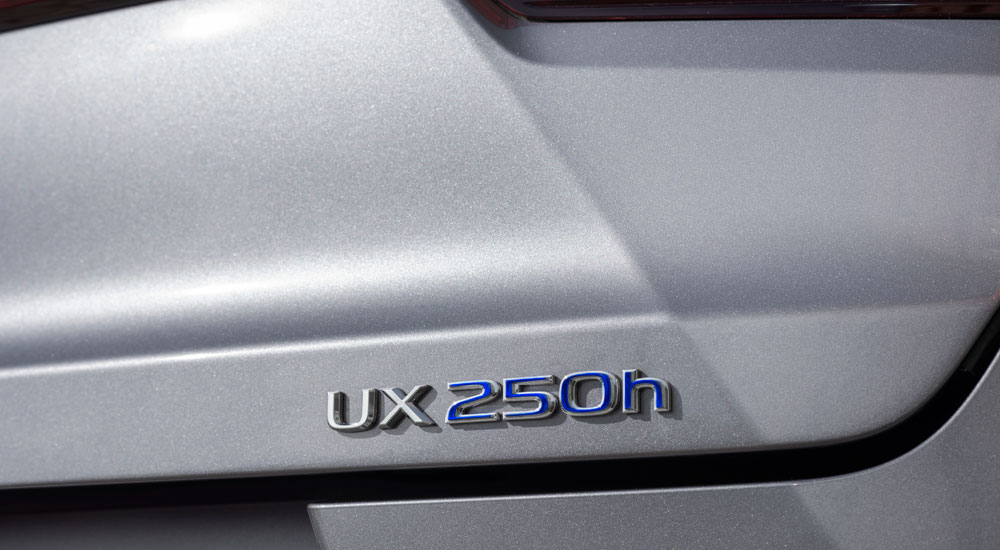
The UX’s new 2.0-litre inline four-cylinder engine is one of the most efficient engines in its class, thanks to revolutionary laser-clad intake valve seats with an all-new intake port profile, high compression ratio (13:1), D4-S fuel injection combining direct and secondary port injectors to achieve high-speed combustion. VVT-iE intelligent variable valve-timing with an electric actuator on the intake side also enhances drivability while reducing emissions.
A continuously variable capacity oil pump and a variable cooling system with an electric water pump contribute to ultra-low internal friction, further optimising engine performance and fuel efficiency. The system also ensures quicker cabin heating on cold days and quicker cool-down when the air conditioner is used.

Exhaust heat recirculation enables quick engine warm-up to reduce emissions, while a gasoline particulate filter provides high-efficiency particulate material removal to conform to EURO6d PN (particulate number) regulations.
The UX’ hybrid system couples this new engine with two electric motor generators in a new-generation hybrid transaxle that is more compact, lighter and has less internal friction than previous Lexus hybrid systems. The Power Control Unit (PCU) is more powerful yet 20% smaller and 10% lighter.
Optimising the level of electric motor assistance and engine rpm produces a linear acceleration feel without the engine running at high revs. Engine speed is synchronised with vehicle speed to create an immediate and continuous acceleration feel.

The new transaxle mounts the electric motor generators (MG1 and MG2) coaxially rather than in-line. The resulting smaller and lighter package reduces frictional losses by 25%. In addition, MG2 is now a higher-speed motor, yielding better performance and efficiency.
The Sequential Shiftmatic feature delivers responsive engine braking force in six steps with a shift feel similar to a manual transmission, using steering wheel paddle shift switches or the S position on the shift lever.
The speed at which the hybrid system can shut off the petrol engine, such as when driving on long downward slopes, has been raised to 115 km/h (71 mph).
The new compact and lightweight nickel metal-hydride (NiMH) battery and compact cooling system are located below the rear seat, which supports the vehicle’s low centre of gravity.
E-FOUR ALL WHEEL DRIVE
The UX 250h is available with either front-wheel drive or E-Four electric all-wheel drive.
The E-Four all-wheel drive system uses a separate, dedicated electric motor generator integrated into the rear differential. Power distribution between the front and rear axles is automatically optimised by the Vehicle Stability Control (VSC) system when accelerating, cornering, or driving on slippery surfaces. E-Four provides stable driving on uphill slopes or snow-covered roads with lower fuel consumption than a conventional all-wheel drive system that employs a power split device and driveshaft. E-Four does more than assist traction in slippery conditions: The system can actively improve stability by adjusting rear-wheel power to help correct an over- or understeer condition.
UX 200: INNOVATIVE TRANSMISSION MEETS ULTRA EFFICIENT ENGINE
The UX 200 is equipped with the same 2.0-litre inline four-cylinder engine as the UX 250h.
At 171 PS, the UX 200 engine offers output similar to some competitors’ lower capacity turbo engines, but with less complexity, less underhood heat and lower powerplant weight for better vehicle balance. The engine produces 205 Nm of peak torque.
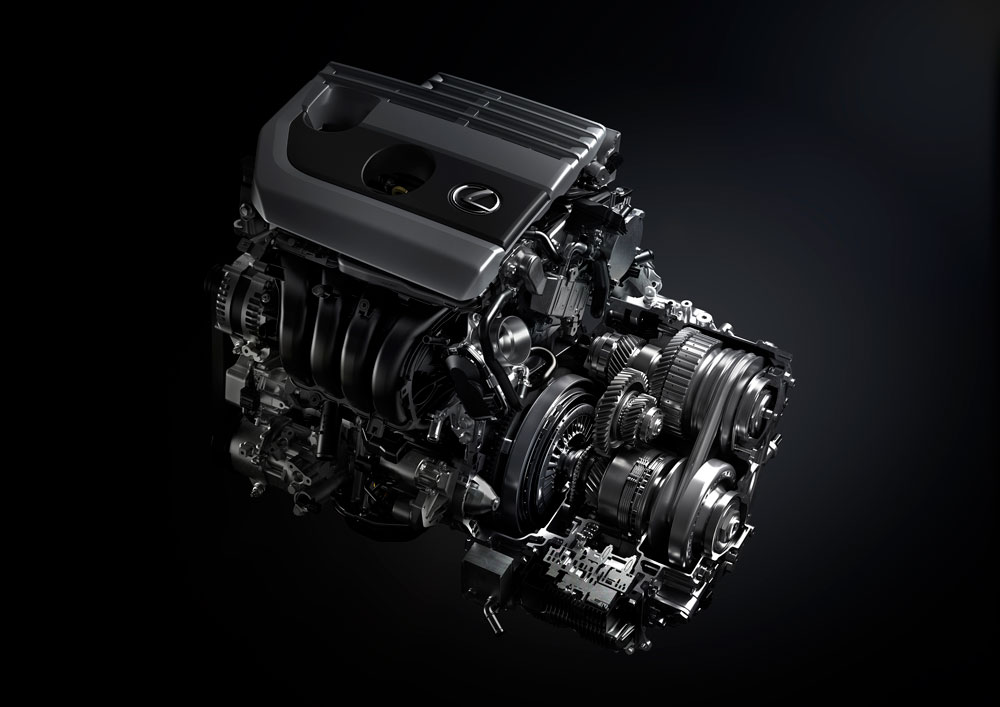
The new Direct-Shift-Continuously Variable Transmission (D-CVT) combines the smooth, fuel-efficient performance of a continuously variable transmission with a more direct driving feel. The key to its distinct performance feel is a mechanical gearset that is used to start from a stand-still and accelerate before handing off to the continuously variable transmission traditional pulley system.
The result is quicker, more linear initial acceleration, while maintaining the benefits of a continuously variable transmission at mid- and higher speeds. Also, because the fixed-ratio first gear reduces the load on the belt and pulleys mechanism for start-off and low-speed driving, the pulley can be made smaller and lighter while providing a wider range of gear ratios. The result is quicker ratio changes during acceleration and an overall ratio spread that maximises fuel efficiency.
Under strong acceleration, the D-CVT can freely adjust the transmission ratio to simulate gear changes like a multi-gear automatic transmission. Synchronisation of the increasing engine revs and vehicle speed provides a linear acceleration feel.
DRIVE MODE SELECT
Both the UX 200 and UX 250h Hybrid are equipped with Lexus Drive Mode Select, which allows the driver to tailor the driving experience by selecting from three different drive modes.
Normal mode provides an optimal balance between driving performance and fuel efficiency; ECO mode maximises fuel savings across all driving conditions by smoothing the throttle response, and by moderating air conditioning operation; Sport Mode delivers quicker throttle response and increased power steering feel.
In Luxury and F SPORT models equipped with AVS, five different driving modes are available: normal, ECO, Sport S, Sport S+, and custom.
SAFETY TECHNOLOGY AND DRIVER ASSIST
The UX models are equipped with eight airbags: driver and front passenger airbags; driver and front passenger knee airbags; driver and front passenger seat-mounted side impact airbags and front to rear side curtain airbags.
The Lexus Safety System+ includes All-Speed Dynamic Radar Cruise Control, Pre-Collision System (PCS) with Pedestrian Detection, Lane Keep Assist with Lane Departure Alert with Steering Assist, Road Sign Assist (RSA), Adaptive High-beam System (AHS) and Intelligent High-Beam headlamps/Automatic High Beam (AHB).
The Pre-Collision System (PCS) couples with Dynamic Radar Cruise Control. The system can operate relative to a vehicle ahead that is traveling 10 to 180 km/h (7 to 110 mph). Dynamic Radar Cruise Control with Road Sign Assist (RSA) can quickly reset the vehicle speed setting in accordance with the speed limit information recognized by RSA.
PCS uses camera-based detection to recognize pedestrians in low light, and its radar capability has been extended to enable detection of cyclists during the day. (In markets where PCS is not available, the UX comes standard with conventional cruise control.)
The UX is capable of low-speed following, including stop-and-go traffic, up to speeds of about 30 km/h (18 mph).. Thus, the UX driver enjoys more relaxed driving in situations that can be normally annoying and fatiguing, while also gaining a measure of safety.
Lane Tracing Assist uses the Electric Power Steering motor to aid the drive in keeping the vehicle centred in its lane. Lane Departure Alert detects not only yellow or white traffic lanes, but also the sides of the road.
Other available safety systems include Parking Support Alert that can detect crossing vehicles from the sides and static vehicles in front of or behind the UX when parking over a broader range of conditions than previous clearance sonar or rear cross traffic systems, and uses digital camera images on the centre display along with a beeper to alert the driver to potential risks.
A related Parking Support Brake system adds active drive force (throttle) and braking control to audible and visual warnings to reduce the possibility of contact with moving objects ahead or behind the UX when parking.
UX F SPORT
The F SPORT package is available for both the UX 200 and UX 250h.
The F SPORT transformation includes an exclusive grille design featuring a mesh-pattern created by individual L-shaped pieces. The exclusive F SPORT front bumper features large fog lamp bezels with L-shaped chrome mouldings and the same mesh pattern as the grille. A revised rear bumper and jet-black trim on the front and rear mouldings complete the F SPORT look.

Two of the available 13 exterior colours, White Nova and Heat Blue, are exclusive to the F SPORT.
F SPORT-exclusive interior features include front sports seats made with an integrated-foaming technique first developed for Lexus F models, which helps the seats conform to the occupant’s body. With this process, the upholstery is set into the mould and is then filled with foam to complete the seat in a single process. The special 8-way power-adjustable F SPORT front seats feature lumbar adjustment, as well as manual forward/backward adjustment for the headrests.
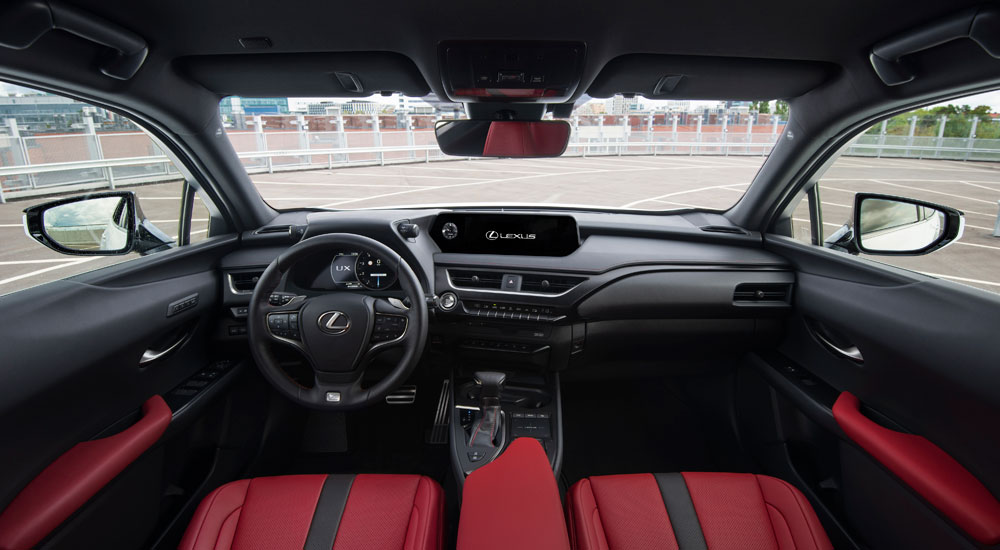
The F SPORT features a larger 8-in. TFT LCD display that varies depending on the powertrain (petrol or hybrid) and the selected drive mode. For the F SPORT only, the movable meter ring, which originated in the Lexus LFA supercar and is also featured in the LC premium coupe, allows displayed content to be easily changed. Pushing a switch on the steering wheel moves the ring to the right and enlarges the multi-information display.
A leather-covered F SPORT steering wheel, leather-trimmed shift knob, aluminium footrest and aluminium pedals are also part of the package.
The UX F SPORT can be equipped with a UX tailored version of the high response Adaptive Variable Suspension (AVS) system that debuted on the Lexus LC and LS flagship models. The system increases damping force to minimize roll when cornering or changing lanes and reduces damping force in straight line driving to preserve ride quality.
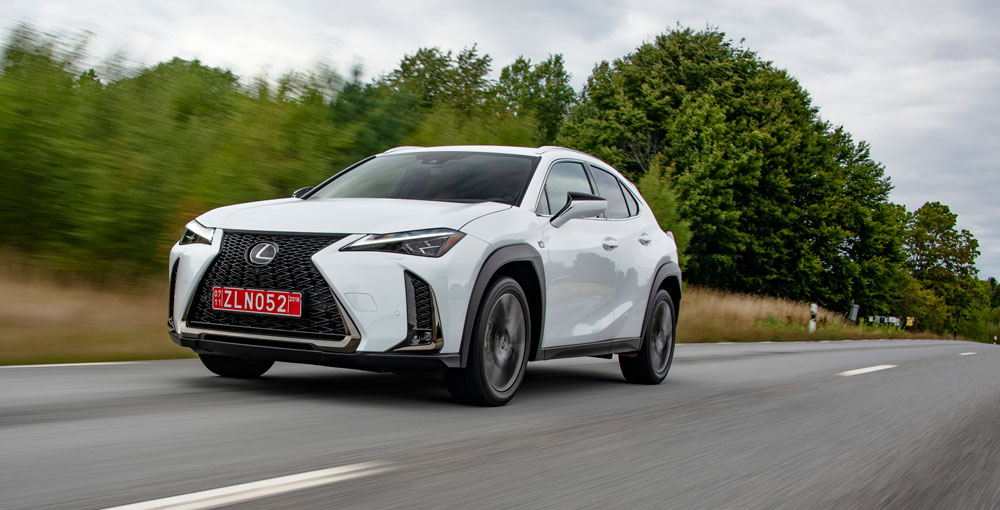
Exclusive F SPORT suspension tuning includes specific springs and stabiliser bars, plus a rear performance damper for a more refined ride. The 18-inch, five twin-spoke aluminium alloy wheels, which are unique to the F SPORT, are even more rigid than standard UX wheels, contributing to responsiveness and handling agility.
The UX F SPORT driving experience can be further enhanced with Active Sound Control (ASC), which generates the aural effect of up- and down-shifts like those of a geared automatic transmission. An additional Sonic Interaction Design (SID) function adjusts the sound the vehicle makes when driving in Sport S+ mode (S+ Sound).

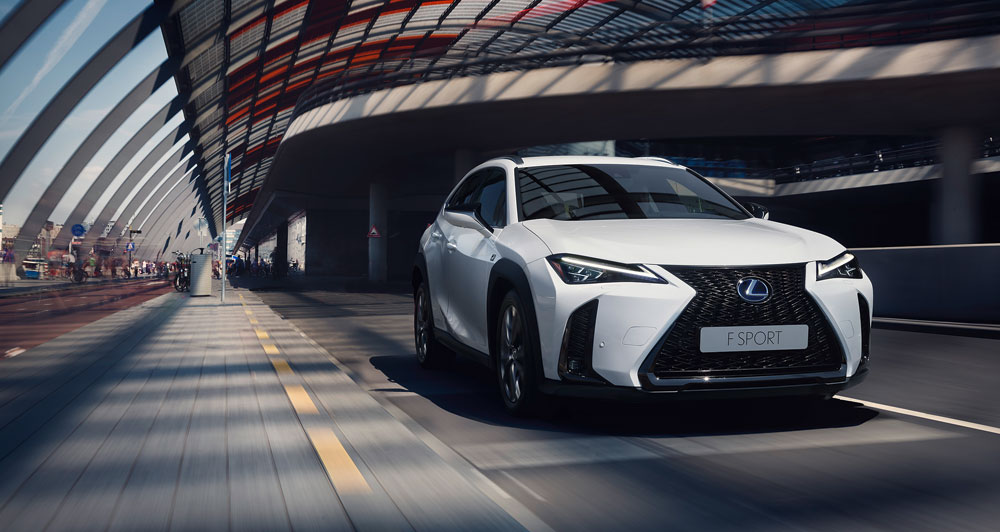

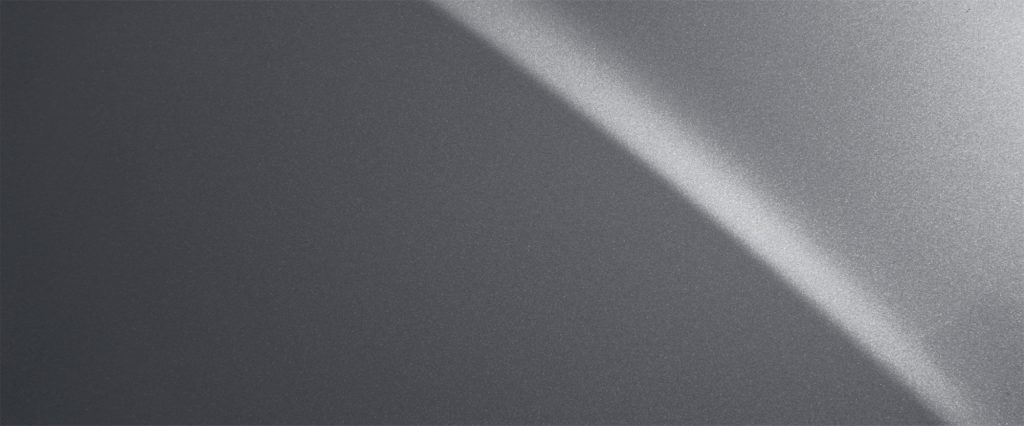











Comments